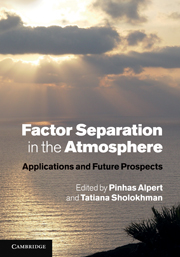Book contents
- Frontmatter
- Contents
- List of contributors
- Foreword
- Preface
- 1 Introduction
- 2 The Factor Separation Methodology and the fractional approach
- 3 Investigation of the Factor Separation features for basic mathematical functions
- 4 Factor Separation Methodology and paleoclimates
- 5 Meso-meteorology: Factor Separation examples in atmospheric meso-scale motions
- 6 Using the Alpert–Stein Factor Separation Methodology for land-use land-cover change impacts on weather and climate process with the Regional Atmospheric Modeling System
- 7 Application of Factor Separation to heavy rainfall and cyclogenesis: Mediterranean examples
- 8 Experience in applying the Alpert–Stein Factor Separation Methodology to assessing urban land-use and aerosol impacts on precipitation
- 9 Free and forced thermocline oscillations in Lake Tanganyika
- 10 Application of the Factor Separation Methodology to quantify the effect of waste heat, vapor and pollution on cumulus convection
- 11 The use of the Alpert–Stein Factor Separation Methodology for climate variable interaction studies in hydrological land surface models and crop yield models
- 12 Linear model for the sea breeze
- 13 Experience and conclusions from the Alpert–Stein Factor Separation Methodology
- 14 Tagging systematic errors arising from different components of dynamics and physics in forecast models
- 15 Some difficulties and prospects
- 16 Summary
- Appendix: References employing the Alpert–Stein Factor Separation Methodology
- References
- Index
9 - Free and forced thermocline oscillations in Lake Tanganyika
Published online by Cambridge University Press: 03 May 2011
- Frontmatter
- Contents
- List of contributors
- Foreword
- Preface
- 1 Introduction
- 2 The Factor Separation Methodology and the fractional approach
- 3 Investigation of the Factor Separation features for basic mathematical functions
- 4 Factor Separation Methodology and paleoclimates
- 5 Meso-meteorology: Factor Separation examples in atmospheric meso-scale motions
- 6 Using the Alpert–Stein Factor Separation Methodology for land-use land-cover change impacts on weather and climate process with the Regional Atmospheric Modeling System
- 7 Application of Factor Separation to heavy rainfall and cyclogenesis: Mediterranean examples
- 8 Experience in applying the Alpert–Stein Factor Separation Methodology to assessing urban land-use and aerosol impacts on precipitation
- 9 Free and forced thermocline oscillations in Lake Tanganyika
- 10 Application of the Factor Separation Methodology to quantify the effect of waste heat, vapor and pollution on cumulus convection
- 11 The use of the Alpert–Stein Factor Separation Methodology for climate variable interaction studies in hydrological land surface models and crop yield models
- 12 Linear model for the sea breeze
- 13 Experience and conclusions from the Alpert–Stein Factor Separation Methodology
- 14 Tagging systematic errors arising from different components of dynamics and physics in forecast models
- 15 Some difficulties and prospects
- 16 Summary
- Appendix: References employing the Alpert–Stein Factor Separation Methodology
- References
- Index
Summary
All year long, the thermocline of Lake Tanganyika (Central Africa) oscillates about two equilibrium states. The thermocline is tilted downward toward the north during the dry season, due to the wind bringing the warm surface water from south to north. The equilibrium position of the thermocline is horizontal during the wet season. The oscillations about these two equilibrium states may be of two types. The free oscillations are due to the seasonal cycle of the wind stress, while the forced oscillations are a direct response to the intraseasonal variability of the surface forcing. It has already been suggested that both have a three- to four- week oscillation period. The Factor Separation method is here used to show that the forced oscillations of the thermocline are about twice as large as the free ones.
Introduction
Lake Tanganyika is located to the east of central Africa, and is shared by four developing countries: Democratic Republic of the Congo, Burundi, Tanzania, and Zambia. It lies between 3° 20′ and 8° 45′ S and 29° 05′ to 31° 15′ E. It is about 650 km long and 50 km wide on average. The mean depth of the lake is about 570 m, with a maximum depth of 1470m (Fig. 9.1). That makes it the second deepest lake in the world, the deepest being Lake Baikal in Russia. Thermal stratification is well marked and present all year long, so that one can identify two distinct layers: the surface and the bottom layers.
- Type
- Chapter
- Information
- Factor Separation in the AtmosphereApplications and Future Prospects, pp. 146 - 162Publisher: Cambridge University PressPrint publication year: 2011
- 3
- Cited by



